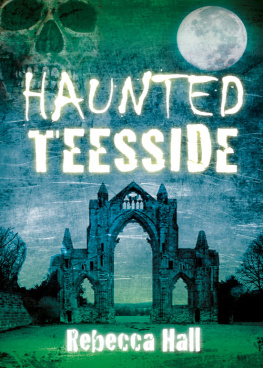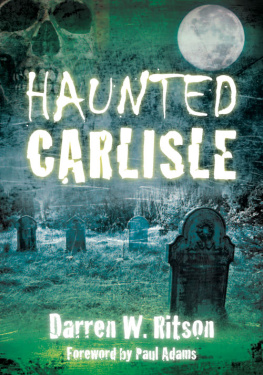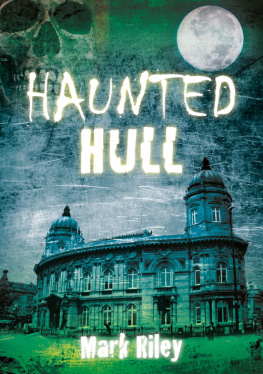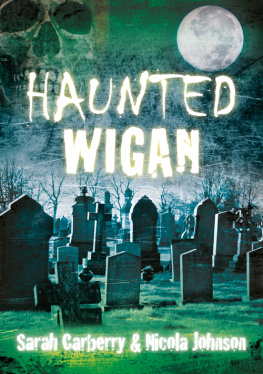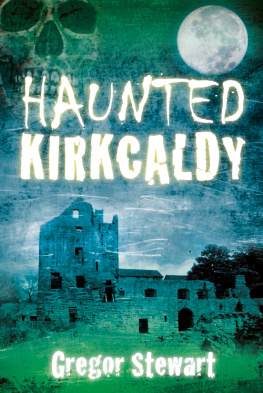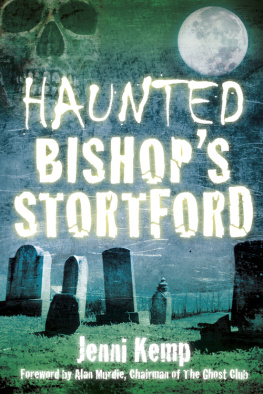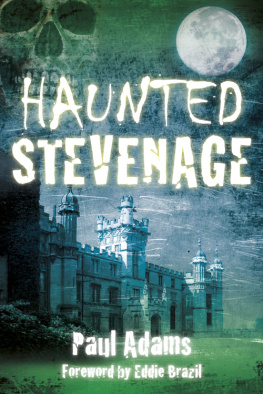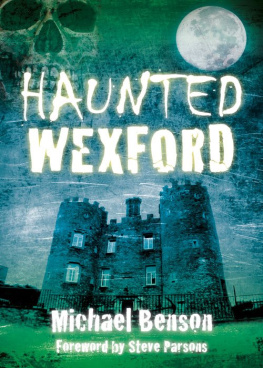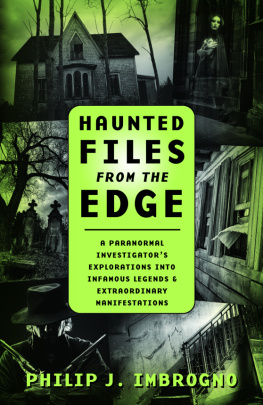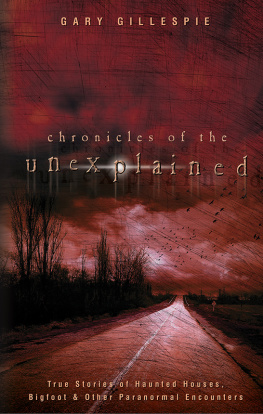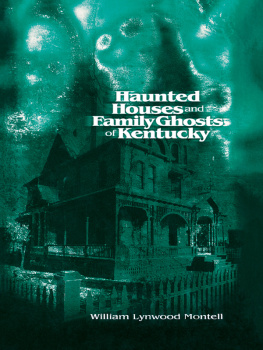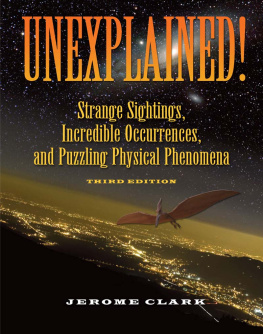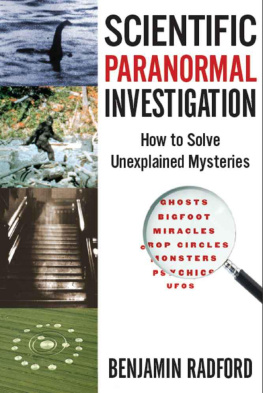
CONTENTS
T HIS book is for anyone who has ever wondered about life after death, or has experienced something that they cannot explain.
It is dedicated to the people of Teesside, both past and present, whose stories and sharing nature made this book possible. With thanks to everyone who helped and contributed, particularly Karl of Spirit Seekers, Brian of G.H.O.S.T. and the members of NGI, the Northern Ghost Investigations team.
Finally, this book is dedicated to Natasha, whose tireless assistance and encouragement made this process a joy, and to Richard, who doesnt believe in ghosts but does believe in me.
T EESSIDE is a mysterious place; it has no concrete location on the map and throughout history its boundaries have been moved and its name has changed time and time again. To this day there are no physical boundaries, but those who live here need no geographical guidelines or markings to tell them where home is.
Teesside is the name given to a region of towns and settlements nestled along the banks of the River Tees. The county borough of Teesside was officially absorbed into the county of Cleveland, literally translating to Cliff-Land, in 1974 and it was at this time that Teesside was split into the recognisable form of today, with the three major boroughs of Middlesbrough, Stockton-on-Tees, and Redcar & Cleveland. In 1996 the county of Cleveland was abolished as a result of a local government reform, which saw Middlesbrough, Stockton and Redcar become unitary authority boroughs in their own right, along with a new addition of Hartlepool. Teesside, however, is a region that was born from industry and traders of industry, along with many local residents, continue to use its name. The town of Middlesbrough, which up until 1801 was a modest farming hamlet with a population of twenty-five, transformed in the early 1800s when the regions first iron foundry was built there. The success that ensued after ironstone was found in the Eston Hills gained Middlesbrough the nickname of Ironopolis, and put Teesside firmly on the industrial map.

Middlesbrough Transporter Bridge. A Steel Dragonfly over the River Tees that has become one of the regions most iconic landmarks. (Photo by Brian Pitt)
Modern Redcar is now dominated by the nearby steelworks, which boasts Europes largest blast furnace. Stockton-on-Tees has roots in the railway industry, with the Stockton to Darlington line transporting passengers on the worlds first steam-powered train in 1825, but it also has links with shipbuilding, as does neighbouring Hartlepool. Early forays into the maritime trade in Hartlepool involved the building of ships and it seems a somewhat poetic contrast that the Teesside Environmental Reclamation and Recycling Centre (TERRC) now operate the largest ship-recycling facility in the country, and Europes largest dry dock is located just outside of the town.

Beautiful view of Roseberry Topping, the most recognisable peak in the silhouette of the Cleveland Hills. Named for its ice-cream whip profile, Roseberry Topping is a popular destination for locals and visitors to the area who climb to the summit to be rewarded with stunning views over Teesside. (Photo by Brian Pitt)
There is, however, far more to Teesside than mining, steelworks and industry. The rolling Cleveland Hills offer a stunning backdrop, while the easily accessible lakes and country parks make for fantastic walks and days out. The sandy beaches at seaside resorts Redcar, Saltburn and Seaton Carew (to name but a few) provide both local residents and visitors to the area with the best of both coastline and countryside settings. Throughout the larger towns and lesser-travelled villages are beautiful buildings and wonderful people. An impressive collection of Grade I and II listed structures, ruins and monasteries provide an ideal setting for ghostly echoes of the past. The people who live here are loyal and passionate. Is there any for reason for this loyalty to fade after they have passed on from the realm of the living? This is just one of the questions that I wanted to explore within this book. Throughout my journey across the region to uncover tales and eyewitness accounts of the ghosts who haunt Teesside, I have placed focus on eerie occurrences within the TS postcode area and over these past months I have met an array of fascinating people, each with their own chilling and enthralling story to tell. I have relayed them as accurately as possible, and respected the wishes of some to remain anonymous. I hope that you will find this collection of sometimes spine-chilling and often thought-provoking legends and accounts as interesting and enjoyable to read as I found it to write.
Rebecca Hall, 2014
The Ghost Room
Standing proudly in Middlesbroughs Centre Square is Middlesbrough Central Library. Opened just two years after the foundation stone was laid in 1910, the striking design is still a beautiful and recognisable landmark of the town. London architects Messrs S.B. Russell and T.E. Cooper entered their design for the building for consideration. Their classical style impressed the board, and was selected to be built from the 203 submissions that were received.
The two plots of land on which the library stands were donated for the cause. One was given by Sir Hugh Bell, and the other by Alderman Amos Hinton, who was granted the honour of officially opening the building on 8 May 1912 as the towns first purpose-built public library. It is a Carnegie library, meaning the construction of the building was funded by Andrew Carnegie, the Scottish-American philanthropist and businessman who ultimately donated money to build a grand total of 2,509 libraries stretching far across the world. At the time of his final donation in 1919, his funding had facilitated the building of almost half of the 3,500 libraries in the USA, a further 660 across Britain and Ireland and his literary legacy had even reached Australia, Mauritius and Fiji, amongst other countries.
The library has undergone many modernisations and renovations over the years. It has been brought into the twenty-first century, and it now holds computer suites instead of the antiquated ladies only reading room and segregated boys and girls lending library with males and females separated with a screen. The grand marble staircase and dark, heavy wooden doors and fittings give visitors a sense of just how grand this building must have been when in its original state. A number of refurbishments have been made and in the 1970s an extension was added to the back of the library, but despite these modern additions many of the original features have been preserved, most notably in the upstairs reference library. It is here that people claim to have seen the ghostly figure of a woman standing above them in the gallery, and members of staff have witnessed one of the original sets of portable steps, used for reaching high shelves, moving around and making banging sounds of its own accord.

As dusk falls Middlesbrough Library takes on an eerie atmosphere. (Authors collection)
Before the neighbouring MIMA (Middlesbrough Institute of Modern Art) was built in 2007, some of the administration offices for the library were housed in a building annexed to the back of the main structure. The annexe had previously been used as an old police station and also a mechanics garage before coming into the councils possession. The basement was used to store the unused taxidermy exhibits for the nearby Dorman Museum, and the offices were upstairs. The building was equipped with an alarm system, and on one occasion the caretaker had been called out in the middle of the night because the alarm had been triggered. When he arrived, there was no sign of forced entry, or indeed entry of any sort. Instead, an enigmatic exit had taken place. He was able to trace the path of the mysterious intruder and, bizarrely, the movement had originated from within the building. The internal doors had then been opened, starting from the centre of the office area and travelling outwards in sequence as whatever was inside had made its way through the building and opened the front door before leaving! Unfortunately, this building no longer stands but I was able to meet with Sue, Julie and Andy, who told me about their unusual experiences and encounters during their time in the main library building.
Next page
